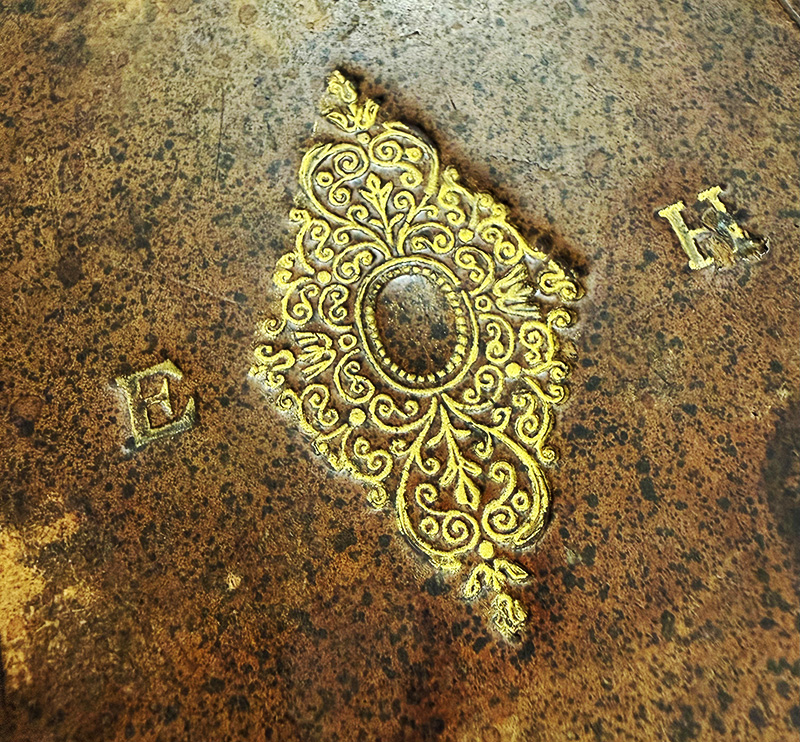
By Emma Laws, Cathedral Librarian
One of the great joys of working with old books is discovering their individual histories – who owned them, when and why. For the past few weeks, we’ve been completing work on the Warminster collection – a donation of books from the library of St Boniface College, Warminster, a former missionary training college which closed permanently in 1969. Today, the building is part of Warminster School.
This little book caught my eye – Thomas Vautroullier’s 1574 Latin edition of Theodore Beza’s New Testament. The binding is 17th century and bears the initials ‘EH’; the flyleaves bear various signatures, including Edward Bell (dated 1623), Martha Bell, and several generations of the Hawtrey family. The earliest Hawtrey owner is Edward, with a signature dated 1642, followed by a John Hawtrey, a Charles Hawtrey, another Edward Hawtrey (this one dated 1680), a Robert Hawtrey, Edward Craven Hawtrey (dated 1828), and a Miss C. Hawtrey, who gave the book to St Boniface College in 1935.
The Hawtreys were a famous Exeter family. In 1903, Florence Molesworth Hawtrey published a history of the family, tracing it from the 11th century and down through various branches across the UK and overseas. The book is a rather muddled read, made worse by the fact that generations of Hawtreys favoured the same names: Ralph, Edward, Charles and John.
The author of the family history, Florence Hawtrey, was the great grand-daughter of Charles Hawtrey (1715-1770), Rector of Heavitree and Sub-Dean of Exeter Cathedral. In his will, Charles committed his soul to God and his body to the south aisle of Exeter Cathedral. His son, Stephen, (Florence’s grandfather) was baptised at Exeter Cathedral on 16 September 1738, became Registrar of Eton College in 1759 and later died of gout. However, Stephen’s sister, Mary (Florence’s great-aunt), has a rather more interesting story.
Mary Hawtrey married the Reverend John Marshall, rector of St John in Fore Street and of St George in South Street. They had three daughters: Mary, Eliza and Anna. The three daughters married: Mary married a Mr Collins, Eliza married a Mr Furze and Anna married Richard Buller, the son of William Buller, Bishop of Exeter from 1792 to 1796.
Bishop William Buller was a great friend of George Austen, father of Jane Austen, and he enlisted his friend to educate his son, Robert. Robert Buller thus lived with the Austens at Steventon Rectory from about 1790 to 1795 and became a very close friend of Jane Austen, corresponding with her until her death in 1806. Through her friendship with Robert Buller, Jane Austen was acquainted not only with Robert’s wife, Anna, but also with Anna’s sisters, Mary and Eliza Hawtrey of Exeter. In fact, Florence Hawtrey writes of her cousins: “It was a well-known and accepted tradition in the family, I am told, that Eliza and Anna were models to Miss Austen, with whom they were acquainted, for her characters Elizabeth and Jane Bennett [sic] in “Pride and Prejudice” but whether this really was the case I cannot say.”
Research can often lead you down a rabbit-hole. Whatever the truth, the Miss Bennets of Exeter makes a good story and I rather like the idea that former Sub-Dean Charles Hawtrey’s grand-daughters were the inspiration for Elizabeth and Jane Bennet. Let’s hope that the Sub-Dean’s grandson-in-law, Mr Collins, wasn’t a real-life counterpart to Austen’s sycophantic clergyman!